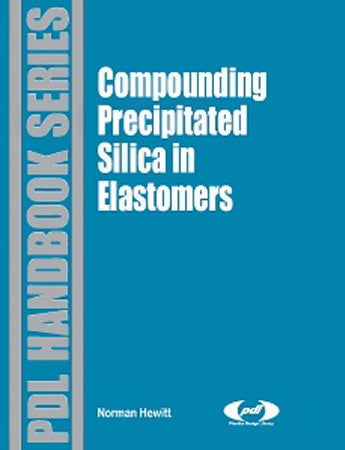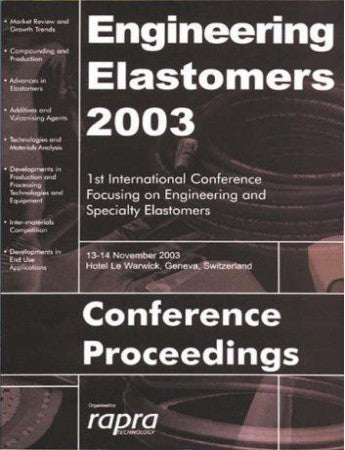Compounding Precipitated Silica in Elastomers, Theory and Practice
Chapter 1: SILICA AS A REINFORCING FILLER
1.1 Introduction
1.2 Manufacture of Precipitated Silica
1.3 Silica and Carbon black
1.4 Silica Surface Area
1.5 Silica Free Water
1.6 Silica Free Water, Affect on Visible Dispersion
1.7 Silica Surface Silanol groups
1.8 Silica pH
1.9 Soluble Salts in Silica
1.10 Physical Form and Sensity of Silica
1.11 Other Silica Properties
1.12 Silane Treated Silicas
Chapter 2: COMPOUNDING PRECIPITATED SILICA IN NATURAL RUBBER
2.1 Introduction
2.2 Silica and Carbon Black
2.3 Activation: Zinc Oxide
2.4 Cure Activation: Glycols
2.5 Acceleration with Secondary Accelerators in Normal Sulfur Systems
2.6 Acceleration: Single Accelerators in Normal Sulfur Systems
2.7 Acceleration: Single Accelerators; Vulcanizate Properties
2.8 Acceleration: Low Sulfur/Sulfur Donor Systems
2.9 Reversion
2.10 Antioxidant Systems: Non-staining
2.11 Plasticization
2.12 Tear Resistance
2.13 Tear Resistance: Contour Curve Studies of Silica Content Effects
2.14 Tear Resistance: Silica Primary Particle Size
2.15 Tear Resistance; Non-Marking Solid tires
2.16 Shelf Aged Stiffness and Green Strength
2.17 Peroxide Cure
2.18 Peroxide Curing: Silica Reinforcement and Structure
2.19 Peroxide Curing: Silica Surface Area
2.20 Peroxide Cure: Silane Coupling
2.21 Silane Coupling: Sulfur Cure Systems
2.22 Zinc-Free Cure Systems
2.23 Zinc-Free Cure Systems: Polyisoprene (IR)
2.24 Brass Adhesion
2.25 Brass Adhesion Mechanism
2.26 Adhesion to Textile Fabrics; the HRH system
2.27 Fabric Adhesion: Dynamic testing
2.28 Heat Resistance
Natural Rubber Formulary
Chapter 3: COMPOUNDING PRECIPITATED SILICA IN EMULSION SBR
3.1 Introduction
3.2 Silica and Carbon Black
3.3 Cure Systems: Activation with Glycols
3.4 Cure System: Zinc Oxide Activation
3.5 Cure System: Magnesium Oxide Activation
3.6 Cure system: Lead oxide (Litharge) Activation
3.7 Cure System: Stearic acid
3.8 Cure Systems: Primary, Secondary Accelerators
3.9 Cure Systems: Single Accelerators
3.10 Cure Systems: Sulfur Concentration
3.11 Plasticization
3.12 Antioxidants
3.13 Tear Resistance: Silica Primary Particle Size
3.14 Tear Resistance: Silica Content
3.15 Fabric Adhesion
3.16 Heat Resistance
3.17 Silane coupling
3.18 Silane Coupling: Competition
Emulsion SBR Formulary
Chapter 4: COMPOUNDING SILICA IN ELASTOMERS SOLUTION SBR AND BR
4.1 Introduction
4.2 Silica and Carbon Black
4.3 Zinc-Free Cure Systems
4.4 Zinc-Free Cure Systems: Accelerators & Sulfur
4.5 Zinc-Free Cure Systems: Polymer Effects
4.6 Zinc-Free Cure Systems: Zinc oxide and HMT
4.7 Zinc-Free Cure Systems: Effects of Additives
4.8 Zinc-Free Cure systems: Sulfur content
4.9 Zinc-Free Cure System: Antioxidants
4.10 Zinc-Free Cure Systems: Processing
4.11 Zinc-Free Systems: Plasticizers
4.12 Zinc-Free Systems: Additive plasticizers
4.13 Silane Coupling: Pretreated Silica
4.14 Silane Coupling
4.15 Zinc-Free Cure Systems: Surface Area Effects
4.16 Zinc-Free Cure Systems: Trouser Tear Strength
4.17 Zinc-Free Cure Systems ; Silica Content
4.18 Zinc-Free Cure Systems: Durometer Equivalents
Solution SBR and BR Formulary
Chapter 5: COMPOUNDING SILICA IN ELASTOMERS EPDM
5.1 Introduction
5.2 Silica and Carbon Black
5.3 Acceleration Systems
5.4 Low Sulfur Systems with Donors
5.5 Activation: Oxides and Glycols
5.6 Antioxidants: Heat Resistance
5.7 Zinc-Free Cure Systems
5.8 Silane Coupling
5.9 Silica Surface Area
5.10 Peroxide Cure Systems
5.11 Processing
5.12 Adhesion to Brass
5.13 Fabric Adhesion
5.14 Adhesion to Zinc (Galvanized) Coatings
5.15 Compression Fatigue Life
EPDM Formulary
Chapter 6: COMPOUNDING PRECIPITATED SILICA IN NEOPRENE
6.1 Introduction
6.2 NSM (Type W) Neoprene: Oxide Crosslinking
6.3 NSM Neoprene (W): Organic Acceleration
6.4 NSM Neoprene: Glycol Activation
6.5 NSM Neoprene: Plasticization
6.6 NSM Neoprene: Silica and Black
6.7 Silica Surface Area
6.8 NSM Neoprene: Silane Coupling
6.9 NSM Neoprene: Fabric Adhesion
6.10 NSM Neoprene: Brass Adhesion
6.11 NSM Neoprene: Water Absorption
6.12 Sulfur Modified (SM) Neoprene: Cure Systems
6.13 SM Neoprene: Glycol Activation
6.14 SM Neoprene: Retarding Scorch
6.15 SM Neoprene: Silane Coupling
6.16 SM Neoprene: Processing
6.17 SM Neoprene: Silica Surface Area effects
6.18 SM Neoprene: Silica Free Water Content
6.19 SM Neoprene: Cord and Fabric Adhesion
6.20 SM Neoprene: Brass Adhesion
Chapter 7: COMPOUNDING PRECIPITATED SILICA IN NITRILE
7.1 Introduction
7.2 Silica and Carbon Black
7.3 Silica Surface Area
7.4 NBR/PVC Blends
7.5 Acceleration: Sulfur Content
7.6 Accelerators
7.7 Activators
7.8 Silane Coupling
7.9 Peroxide Curing
7.10 Processing
7.11 Zinc-Free Cure Systems
7.12 Phenolic Resins
7.13 NBR Adhesion to Brass
7.14 NBR Adhesion to Fabric
Nitrile Formulary
Appendix A: COMPOUNDING BASICS
Appendix B: COMPOUNDING MATERIALS
Appendix C: RUBBER PROCESSING
Appendix D: PHYSICAL TESTING OF RUBBERAppendix E: COMMON COMPOUNDING ABBREVIATIONS
INDEX
This valuable guide to compounding elastomers with precipitated silica covers principles, properties, mixing, testing and formulations from a practical perspective. This handbook and reference manual will serve those who work on part design, elastomer formulation, manufacturing and applications of elastomers. Ample discussion of compound specifications adds to the usefulness of this book to practitioners. Comparisons of carbon black and silica compounds throughout the book allow readers to select the most suitable formulation for applications ranging from tires to electrical insulation to shoe soles.
The author has over forty years of experience in the rubber industry highlighted by his 39 years at the PPG Rubber Research laboratories. A highlight of the book is the inclusion of studies conducted by the author which greatly adds to the richness of the contents.
The author has over forty years of experience in the rubber industry highlighted by his 39 years at the PPG Rubber Research laboratories. A highlight of the book is the inclusion of studies conducted by the author which greatly adds to the richness of the contents.
Chapter 1: SILICA AS A REINFORCING FILLER
1.1 Introduction
1.2 Manufacture of Precipitated Silica
1.3 Silica and Carbon black
1.4 Silica Surface Area
1.5 Silica Free Water
1.6 Silica Free Water, Affect on Visible Dispersion
1.7 Silica Surface Silanol groups
1.8 Silica pH
1.9 Soluble Salts in Silica
1.10 Physical Form and Sensity of Silica
1.11 Other Silica Properties
1.12 Silane Treated Silicas
Chapter 2: COMPOUNDING PRECIPITATED SILICA IN NATURAL RUBBER
2.1 Introduction
2.2 Silica and Carbon Black
2.3 Activation: Zinc Oxide
2.4 Cure Activation: Glycols
2.5 Acceleration with Secondary Accelerators in Normal Sulfur Systems
2.6 Acceleration: Single Accelerators in Normal Sulfur Systems
2.7 Acceleration: Single Accelerators; Vulcanizate Properties
2.8 Acceleration: Low Sulfur/Sulfur Donor Systems
2.9 Reversion
2.10 Antioxidant Systems: Non-staining
2.11 Plasticization
2.12 Tear Resistance
2.13 Tear Resistance: Contour Curve Studies of Silica Content Effects
2.14 Tear Resistance: Silica Primary Particle Size
2.15 Tear Resistance; Non-Marking Solid tires
2.16 Shelf Aged Stiffness and Green Strength
2.17 Peroxide Cure
2.18 Peroxide Curing: Silica Reinforcement and Structure
2.19 Peroxide Curing: Silica Surface Area
2.20 Peroxide Cure: Silane Coupling
2.21 Silane Coupling: Sulfur Cure Systems
2.22 Zinc-Free Cure Systems
2.23 Zinc-Free Cure Systems: Polyisoprene (IR)
2.24 Brass Adhesion
2.25 Brass Adhesion Mechanism
2.26 Adhesion to Textile Fabrics; the HRH system
2.27 Fabric Adhesion: Dynamic testing
2.28 Heat Resistance
Natural Rubber Formulary
Chapter 3: COMPOUNDING PRECIPITATED SILICA IN EMULSION SBR
3.1 Introduction
3.2 Silica and Carbon Black
3.3 Cure Systems: Activation with Glycols
3.4 Cure System: Zinc Oxide Activation
3.5 Cure System: Magnesium Oxide Activation
3.6 Cure system: Lead oxide (Litharge) Activation
3.7 Cure System: Stearic acid
3.8 Cure Systems: Primary, Secondary Accelerators
3.9 Cure Systems: Single Accelerators
3.10 Cure Systems: Sulfur Concentration
3.11 Plasticization
3.12 Antioxidants
3.13 Tear Resistance: Silica Primary Particle Size
3.14 Tear Resistance: Silica Content
3.15 Fabric Adhesion
3.16 Heat Resistance
3.17 Silane coupling
3.18 Silane Coupling: Competition
Emulsion SBR Formulary
Chapter 4: COMPOUNDING SILICA IN ELASTOMERS SOLUTION SBR AND BR
4.1 Introduction
4.2 Silica and Carbon Black
4.3 Zinc-Free Cure Systems
4.4 Zinc-Free Cure Systems: Accelerators & Sulfur
4.5 Zinc-Free Cure Systems: Polymer Effects
4.6 Zinc-Free Cure Systems: Zinc oxide and HMT
4.7 Zinc-Free Cure Systems: Effects of Additives
4.8 Zinc-Free Cure systems: Sulfur content
4.9 Zinc-Free Cure System: Antioxidants
4.10 Zinc-Free Cure Systems: Processing
4.11 Zinc-Free Systems: Plasticizers
4.12 Zinc-Free Systems: Additive plasticizers
4.13 Silane Coupling: Pretreated Silica
4.14 Silane Coupling
4.15 Zinc-Free Cure Systems: Surface Area Effects
4.16 Zinc-Free Cure Systems: Trouser Tear Strength
4.17 Zinc-Free Cure Systems ; Silica Content
4.18 Zinc-Free Cure Systems: Durometer Equivalents
Solution SBR and BR Formulary
Chapter 5: COMPOUNDING SILICA IN ELASTOMERS EPDM
5.1 Introduction
5.2 Silica and Carbon Black
5.3 Acceleration Systems
5.4 Low Sulfur Systems with Donors
5.5 Activation: Oxides and Glycols
5.6 Antioxidants: Heat Resistance
5.7 Zinc-Free Cure Systems
5.8 Silane Coupling
5.9 Silica Surface Area
5.10 Peroxide Cure Systems
5.11 Processing
5.12 Adhesion to Brass
5.13 Fabric Adhesion
5.14 Adhesion to Zinc (Galvanized) Coatings
5.15 Compression Fatigue Life
EPDM Formulary
Chapter 6: COMPOUNDING PRECIPITATED SILICA IN NEOPRENE
6.1 Introduction
6.2 NSM (Type W) Neoprene: Oxide Crosslinking
6.3 NSM Neoprene (W): Organic Acceleration
6.4 NSM Neoprene: Glycol Activation
6.5 NSM Neoprene: Plasticization
6.6 NSM Neoprene: Silica and Black
6.7 Silica Surface Area
6.8 NSM Neoprene: Silane Coupling
6.9 NSM Neoprene: Fabric Adhesion
6.10 NSM Neoprene: Brass Adhesion
6.11 NSM Neoprene: Water Absorption
6.12 Sulfur Modified (SM) Neoprene: Cure Systems
6.13 SM Neoprene: Glycol Activation
6.14 SM Neoprene: Retarding Scorch
6.15 SM Neoprene: Silane Coupling
6.16 SM Neoprene: Processing
6.17 SM Neoprene: Silica Surface Area effects
6.18 SM Neoprene: Silica Free Water Content
6.19 SM Neoprene: Cord and Fabric Adhesion
6.20 SM Neoprene: Brass Adhesion
Chapter 7: COMPOUNDING PRECIPITATED SILICA IN NITRILE
7.1 Introduction
7.2 Silica and Carbon Black
7.3 Silica Surface Area
7.4 NBR/PVC Blends
7.5 Acceleration: Sulfur Content
7.6 Accelerators
7.7 Activators
7.8 Silane Coupling
7.9 Peroxide Curing
7.10 Processing
7.11 Zinc-Free Cure Systems
7.12 Phenolic Resins
7.13 NBR Adhesion to Brass
7.14 NBR Adhesion to Fabric
Nitrile Formulary
Appendix A: COMPOUNDING BASICS
Appendix B: COMPOUNDING MATERIALS
Appendix C: RUBBER PROCESSING
Appendix D: PHYSICAL TESTING OF RUBBERAppendix E: COMMON COMPOUNDING ABBREVIATIONS
INDEX
PPG (former).
Norman Hewitt worked for 39 years with PPG and his work with precipitated silica is world renowned. His technical service activity with PPG included research and development projects on the mechanism and application of reinforcing silica in the rubber industry. This book is the culmination of his more than four decades of experience in the rubber industry.
Norman Hewitt worked for 39 years with PPG and his work with precipitated silica is world renowned. His technical service activity with PPG included research and development projects on the mechanism and application of reinforcing silica in the rubber industry. This book is the culmination of his more than four decades of experience in the rubber industry.




